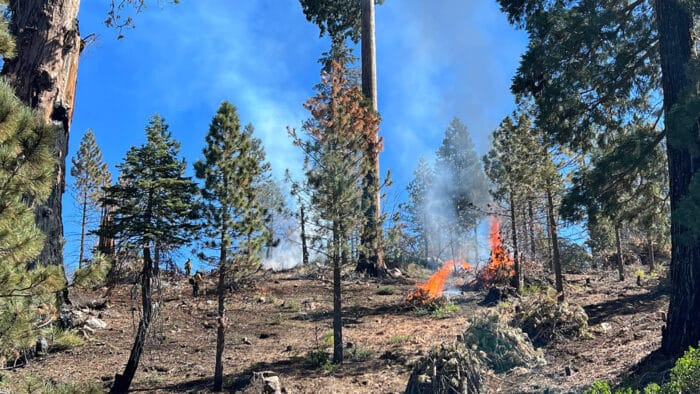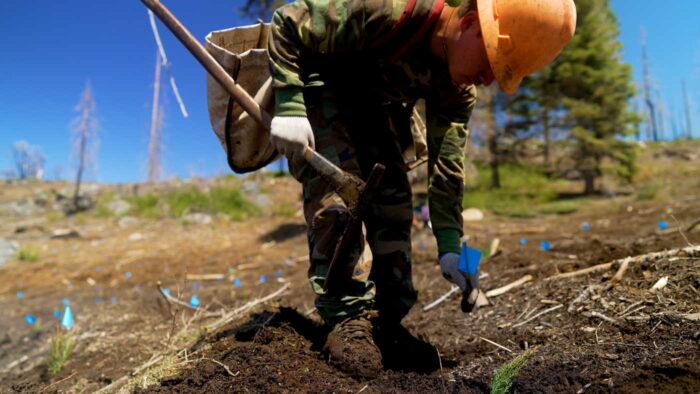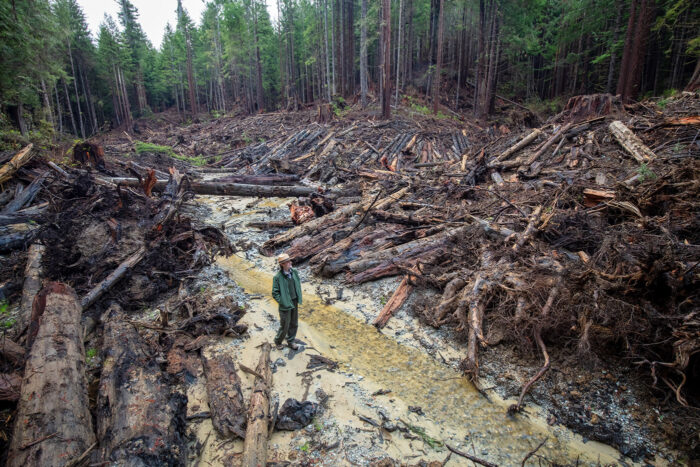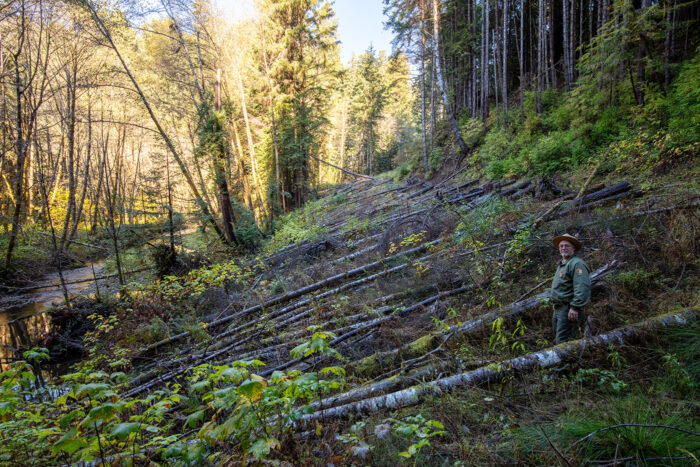Why We Restore
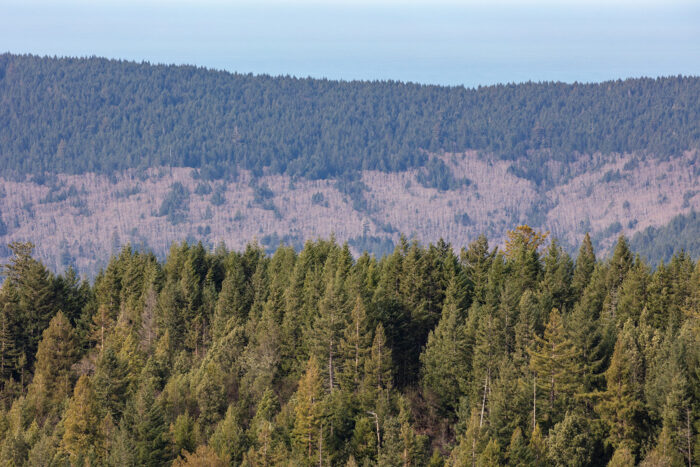
California is the only place in the world where the primeval coast redwood and giant sequoia naturally occur. These exceptional trees have long inspired the world with their natural beauty, massive scale, and resilience—connecting us with something bigger and much older than ourselves. Today, giant sequoias face near extinction and previously logged coast redwood forests are struggling to thrive. How did we get here?
Giant Sequoia Survival Depends on Fire Resilience
Fewer than 80 groves of monarch sequoias (the oldest and largest sequoias) remain, rising from a narrow band that stretches for 250 miles along the western slope of the Sierra Nevada.
In recent years, record-breaking wildfires have ripped through these groves, killing nearly 20% of the remaining monarchs. These wildfires were exacerbated by the violent interruption of Indigenous land stewardship, more than 100 years of misguided fire suppression, and increasingly hot and dry climate conditions.
“Things changed by an order of magnitude. We realized the big trees were facing an existential crisis.” —Ben Blom, director of stewardship and restoration for the Save the Redwoods League, speaking to the New York Times
Frequent, low- and moderate-severity wildfires used to naturally clear out thick brush and smaller trees. Today, these fires are rarely allowed to burn unchecked. This has resulted in a dangerous buildup of parched undergrowth, which fuels severe wildfires and creates “fire ladders” for flames to climb hundreds of feet into the trees’ crowns.
Extreme fires endanger all redwoods, but the giant sequoias are particularly vulnerable. Unlike its coast redwood cousins that can resprout from living roots, when a 2,000-year-old giant sequoia dies, it is gone forever.
In areas that have been severely burned, not enough seeds and seedlings are surviving to ensure that these forests will regenerate on their own. At best, reproduction decreased to less than half the usual rate, and in some places it dropped to as low as 1%.
Restoration Creates Future Old-Growth Coast Redwood Forests
More than 120 years of unrestrained commercial timber harvesting reduced the world’s only old-growth coast redwood forest to just 5% of its original 2.2 million acres. While 1.6 million acres of previously logged coast redwoods are growing back, even protected areas still bear the scars of past harvests.
Thousands of acres of trees remain unnaturally crowded, which stunts their growth and leaves them vulnerable to high-severity wildfires. Plus, industrial logging not only took away huge, ancient trees; it also left behind heavily damaged streams and hundreds of miles of old, failing roads and stream crossings, destroying habitat for salmon and other sensitive aquatic creatures.
We are also working to restore severely burned groves and parks, particularly in the Santa Cruz Mountains, where the 2020 CZU Complex Fire engulfed more than 86,000 acres, killing thousands of ancient coast redwood trees.
Despite these challenges, reviving the old-growth forests is possible. New coast redwoods can sprout from ancient roots—even after wildfires have destroyed the rest of the tree. And young, regrowing forests can begin to assume old-growth characteristics within just a few human lifetimes.
Climate and Biodiversity Superheroes
Restoring redwood forests is crucial, in no small part because these trees are important allies in the fight against climate change. Old-growth coast redwoods store more carbon per acre than any other forest type on Earth, and even young redwoods accumulate significant carbon stores in a relatively short time. Some redwood forests logged in the mid-1800s have already accumulated as much as 339 metric tons of carbon per acre—the equivalent of taking 270 passenger vehicles off the road for one year. This level of carbon storage can have profound benefits when extended across the 1.6 million acres of second-growth redwood forest that could be restored and protected.
These forests also support biodiversity by anchoring entire ecosystems of other species, including the imperiled marten (a member of the weasel family), foothill yellow-legged frog, northern goshawk, western lily, and Anderson’s manzanita. Critically, many vulnerable plants and animals require homes that are exclusively found in ancient forests. For example, endangered northern spotted owls and threatened marbled murrelets rely on the big trees’ large cavities and branches for their nests. In fact, the Pacific fisher (a relative of the mink and otter) in the southern Sierra Nevada range was listed as endangered 2020 precisely because it lost its habitat when forests converted to shrubland following severe wildfires.
Our Commitment to the Forests of Today and Tomorrow
Restoring the redwood forests isn’t just about saving redwoods. It’s about healing damaged ecosystems on a massive scale. A healthy forest anchors soil, purifies water and air, provides abundant wildlife habitat, and helps mitigate climate change.
Our goal is to undo the damage people have done to these vital ecosystems and fast-track their return to health. While a truly old-growth forest may take hundreds of years to develop, some qualities, such as a diverse understory and shelter for wildlife, can be created within decades. With thoughtful, science-backed work, we can bring back a vibrant redwood forest of the scale and grandeur that once graced California—protected forever and restored to grow old again.
How We Restore
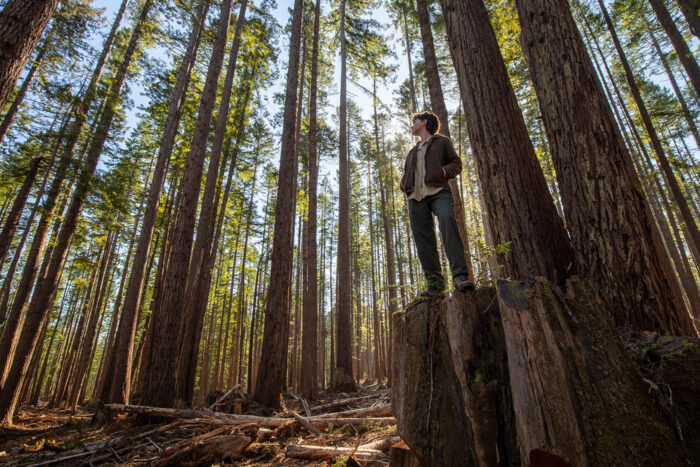
Among the giant sequoias, we are focused on removing excess combustible vegetation and restoring wildfire resilience. In the coast redwood range, the League and our partners are helping to heal logged and severely burned forests and return them to their natural state.
Giant Sequoia Range: Reducing Fuels and Replanting Seedlings
In response to critical threats to the giant sequoias, the League and a coalition of state, federal, tribal, nonprofit, and academic partners formed the Giant Sequoia Lands Coalition (GSLC) in 2022. Together we are focused on restoring wildfire resilience and ensuring the long-term survival of the giant sequoia’s only remaining natural habitat.
Reducing Dangerous Fire Fuels
We remove excess combustible vegetation and reduce the number of small trees that can act as dangerous “ladder fuels,” which allow flames to climb high into the giant sequoias’ seed-bearing crowns. This work returns groves to a more natural state of fire resilience and positively changes the behavior of wildfires. It slows the fire’s spread, lowers its intensity, and reduces the production of smoke.
Since 2022, the GSLC has reduced wildfire fuels across more than 14,000 acres in the giant sequoia range. Moving forward, we hope to maintain this balance using beneficial natural fire as our primary fuel-reduction tool.
Replanting in Severely Burned Areas
Giant sequoia forests require tens of thousands of seeds per acre to regrow. Tragically, recent high-severity wildfires have destroyed far too many seeds for these mighty forests to regenerate everywhere on their own.
If we don’t replant soon after a severe fire, brush can take hold, crowding out seedlings and absorbing the moisture they need to survive. To prevent forests from converting to shrublands, the League and our partners have planted more than half a million giant sequoia and other native tree seedlings over the last few years.
Coast Redwood Range: Undoing Past Damage
The League is restoring coast redwood forests throughout their 450-mile-long range, from California’s North Coast to the Santa Cruz Mountains in the south.
In Redwood National and State Parks, the League has undertaken Redwoods Rising, a large-scale joint project with California State Parks and the National Park Service. Collectively, these parks are a UNESCO World Heritage Site and home to nearly half of the world’s remaining old-growth coast redwood forests. The project’s ambitious goal is to rehabilitate 70,000 acres of timberlands, so that they may become the ancient redwood forests of the future.
Thinning Unnaturally Dense Stands
The timber industry replanted redwoods in dense, uniform groves for commercial harvest. Today, thousands of acres of crowded young redwoods face too much competition for light, water, and nutrients to grow into giants. Left packed together, their growth slows, their needles and branches die, and entire stands grow spindly and dark.
Restoration thinning—removing select, young trees—reduces competition and helps the remaining trees flourish. Redwoods in thinned groves have bigger crowns, greater diameter, and thicker bark, which increases their resistance to fire and pests. As trees grow larger and older, they are also able to store more carbon in decay-resistant heartwood.
Improving Stream Health
Many salmon and steelhead trout used to swim up the cool, redwood-shaded streams to spawn and eventually die. Their remains would then fertilize the forest with nitrogen and other nutrients. Today, most of the salmon and trout species that once thrived here are imperiled, and the resulting decrease in nutrients has slowed the growth of coast redwoods.
To bring back these fish, we’re working to revive the streams that were destroyed or buried during industrial timber operations. That work includes planting trees to stabilize stream banks, removing culverts that block fish, and placing log structures in the water to replicate the fallen redwoods that once created calm refuges for fish.
Removing Eroding Roads
Timber operations also left behind hundreds of miles of old roads and makeshift bridges (essentially piles of bulldozed trees and dirt). These abandoned pathways are now eroding and rain is washing away soil that the forest needs. And runoff and collapsed bridges are choking streams and suffocating fish eggs, further risking the survival of imperiled salmon and steelhead trout.
As we remove the maze of roads and crossings, we restore the land’s contours and plant trees to control erosion. This essentially resets the topography and waterways, so that the forest can begin to heal itself.
Rehabilitating Severely Burned Forests
In areas that have been severely burned, we remove excess dead plant material and other wildfire fuels, while also being careful to leave behind larger dead trees, or “snags,” that wildlife needs for habitat.
Additionally, we plant new seedlings and conduct research to gain a deeper understanding of fire’s impact. Our hope is to better prepare these forests so that they can withstand any future wildfires.
